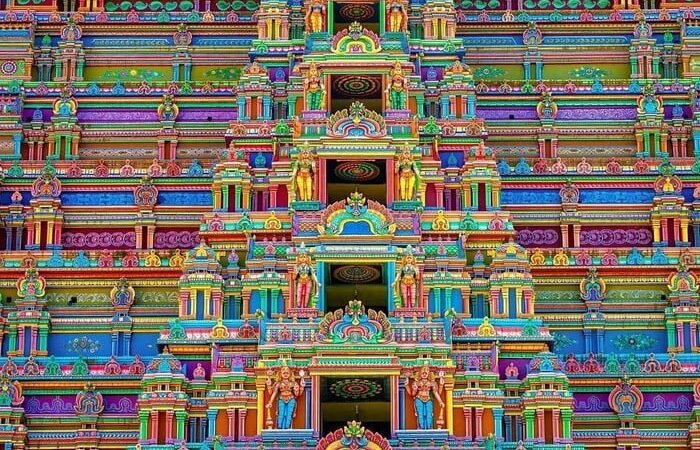Temples with symmetry in their architectural design are often created to reflect principles of cosmic order, divine harmony, and balance. Symmetry in architecture serves both functional and symbolic purposes, and in Hindu temple architecture, it plays a central role in ensuring that the structure is aligned with spiritual, cosmic, and mathematical principles. Here’s a breakdown of symmetry in temple architecture, focusing on its use in Hindu temples:
1. Principles of Symmetry in Hindu Temple Architecture
- Cosmic Order (Vastu Shastra): In Hinduism, Vastu Shastra (the ancient Indian science of architecture) emphasizes the creation of spaces that are harmonious with natural and cosmic forces. Symmetry is key to this idea, as it represents balance, alignment, and the orderly structure of the universe.
- Divine Balance: Symmetry symbolizes the balance between the material world and the divine, ensuring that the temple structure is designed in a way that facilitates spiritual harmony and the flow of positive energy.
- Mathematical Precision: Ancient architects often used mathematical ratios, proportions, and symmetry to ensure the structure aligns with celestial proportions. This is a way of ensuring that the temple, as a divine space, is in sync with cosmic energies.
2. Types of Symmetry Used in Temple Design
- Bilateral Symmetry: This is the most common form of symmetry in temples. It refers to the mirror-image symmetry along a central axis, where both sides of the temple are identical or nearly identical. This symmetry is often seen in the arrangement of the entrance, the layout of rooms, the positioning of deities, and the alignment of structural elements such as columns and pillars.
- Example: The Ramanathaswamy Temple in Rameswaram is known for its symmetrical design, with its long colonnades and similar layout on both sides of the temple.
- Radial Symmetry: This type of symmetry involves elements radiating out from a central point. The sanctum sanctorum (the innermost chamber where the main deity resides) is typically at the center, and all architectural elements, such as walls, pillars, and courtyards, are arranged in a radial pattern around it.
- Example: Sun Temple at Konark, which is designed in the shape of a chariot, has radial symmetry, where every element, including wheels and spokes, radiates from the central sanctum.
- Central Symmetry: Central symmetry is a design where the key focus (often the sanctum or central altar) is located at the center of the temple. The design elements, such as hallways, columns, and outer walls, extend symmetrically around this central point.
- Example: The Brihadeeswarar Temple in Thanjavur demonstrates central symmetry in its grand design. The temple’s central sanctum is flanked by symmetrical courtyards and halls.
3. Architectural Elements That Reflect Symmetry
- Mandapa (Pavilion): A central Mandapa is often symmetrically designed with equal space on either side, sometimes forming a hall that leads to the sanctum sanctorum.
- Example: The Meenakshi Temple in Madurai, with its large hall of a thousand pillars, exhibits symmetry in the placement of columns and sculptures.
- Pradakshina Path (Circumambulatory Path): This circular or square path around the sanctum is often symmetrically designed, guiding devotees in a ritualistic walk around the central deity. It reflects the divine order and the cycle of life.
- Example: The Kashi Vishwanath Temple in Varanasi has symmetrical paths and courtyards around the sanctum for circumambulation.
- Toranas (Archways): Symmetrical toranas or gateways often mark the entrance of temples, framing the sacred space in a balanced, ceremonial manner.
- Example: The Mahabalipuram Shore Temple features symmetrical gateway designs that align with the temple’s structure.
4. Famous Temples with Symmetrical Designs
- Brihadeeswarar Temple (Thanjavur, Tamil Nadu):
- Built by the Chola dynasty in the 11th century, this temple features an enormous central dome (Shikhara), which is perfectly aligned with the central sanctum. The courtyards, pillared halls, and gateways are symmetrically arranged around the central structure.
- The temple follows the principles of Vastu Shastra, ensuring that every element is designed to reflect divine order.
- Sun Temple (Konark, Odisha):
- The Sun Temple is a stunning example of radial symmetry, designed to represent the chariot of the Sun God. The temple is arranged so that the rays of the sun fall upon the deity at specific times of the day, symbolizing divine harmony. The temple’s 12 pairs of wheels and the radial design of the structure showcase perfect symmetry.
- Ramanathaswamy Temple (Rameswaram, Tamil Nadu):
- Known for its grand colonnaded halls, this temple exhibits perfect bilateral symmetry, with long corridors and symmetrical entrances on both sides of the temple. The temple layout ensures a direct alignment with cosmic principles, often seen in temple designs from the Dravidian architectural style.
- Akshardham Temple (Delhi):
- Though a modern example, the Akshardham Temple is built with symmetrical features, reflecting the architectural harmony seen in classical Hindu temples. The central sanctum is aligned with the symmetrical rows of pillars, gardens, and water features, making it a modern yet traditionally symmetrical space.
5. Significance of Symmetry in Temple Architecture
- Spiritual Harmony: Symmetry in temple design ensures that the space aligns with divine principles of balance and cosmic order. This is believed to bring spiritual benefits to both worshippers and the temple itself.
- Aesthetic Appeal: Symmetrical designs are visually appealing and provide a sense of balance and tranquility. The even distribution of space and elements creates a calm environment conducive to meditation and prayer.
- Alignment with Celestial Forces: Many temples are aligned with celestial bodies like the sun, moon, and stars. The symmetrical design ensures that the temple is in harmony with these cosmic entities, enhancing the divine connection during rituals.
6. Conclusion
Symmetry in temple architecture is not merely a visual aesthetic but a representation of divine order and cosmic balance. It reflects the principles of Vastu Shastra, which align human structures with the natural world and the divine. From bilateral to radial symmetry, temples throughout India use these principles to create spaces that foster spiritual experiences, embodying harmony, balance, and divine presence in their design.
